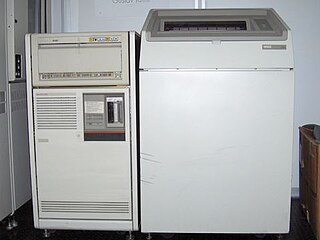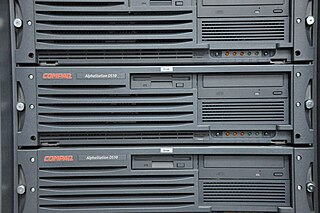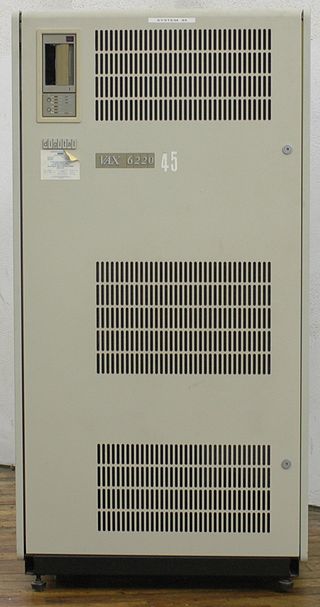Related Research Articles

Alpha is a 64-bit reduced instruction set computer (RISC) instruction set architecture (ISA) developed by Digital Equipment Corporation (DEC). Alpha was designed to replace 32-bit VAX complex instruction set computers (CISC) and to be a highly competitive RISC processor for Unix workstations and similar markets.

The PDP–11 is a series of 16-bit minicomputers sold by Digital Equipment Corporation (DEC) from 1970 into the late 1990s, one of a set of products in the Programmed Data Processor (PDP) series. In total, around 600,000 PDP-11s of all models were sold, making it one of DEC's most successful product lines. The PDP-11 is considered by some experts to be the most popular minicomputer.

The DECstation was a brand of computers used by DEC, and refers to three distinct lines of computer systems—the first released in 1978 as a word processing system, and the latter two both released in 1989. These comprised a range of computer workstations based on the MIPS architecture and a range of PC compatibles. The MIPS-based workstations ran ULTRIX, a DEC-proprietary version of UNIX, and early releases of OSF/1.

TURBOchannel is an open computer bus developed by DEC by during the late 1980s and early 1990s. Although it is open for any vendor to implement in their own systems, it was mostly used in Digital's own systems such as the MIPS-based DECstation and DECsystem systems, in the VAXstation 4000, and in the Alpha-based DEC 3000 AXP. Digital abandoned the use of TURBOchannel in favor of the EISA and PCI buses in late 1994, with the introduction of their AlphaStation and AlphaServer systems.
DeskStation Technology was a manufacturer of RISC-based computer workstations intended to run Windows NT. DeskStation was based in Lenexa, Kansas.
The Multia, later re-branded the Universal Desktop Box, was a line of desktop computers introduced by Digital Equipment Corporation on 7 November 1994. The line is notable in that units were offered with either an Alpha AXP or Intel Pentium processor as the CPU, and most hardware other than the backplane and CPU were interchangeable. Both the Alpha and Intel versions were intended to run Windows NT.

The VAXstation is a discontinued family of workstation computers developed and manufactured by Digital Equipment Corporation using processors implementing the VAX instruction set architecture. VAXstation systems were typically shipped with either the OpenVMS or ULTRIX operating systems. Many members of the VAXstation family had corresponding MicroVAX variants, which primarily differ by the lack of graphics hardware.

The NVAX is a CMOS microprocessor developed and produced by Digital Equipment Corporation (DEC) that implemented the VAX instruction set architecture (ISA). A variant of the NVAX, the NVAX+, differed in the bus interface and external cache supported, but was otherwise identical in regards to microarchitecture. The NVAX+ was designed to have the same bus as the DECchip 21064, allowing drop-in replacement.

The MicroVAX is a discontinued family of low-cost minicomputers developed and manufactured by Digital Equipment Corporation (DEC). The first model, the MicroVAX I, was introduced in 1983. They used processors that implemented the VAX instruction set architecture (ISA) and were succeeded by the VAX 4000. Many members of the MicroVAX family had corresponding VAXstation variants, which primarily differ by the addition of graphics hardware. The MicroVAX family supports Digital's VMS and ULTRIX operating systems. Prior to VMS V5.0, MicroVAX hardware required a dedicated version of VMS named MicroVMS.

AlphaStation is the name given to a series of computer workstations, produced from 1994 onwards by Digital Equipment Corporation, and later by Compaq and HP. As the name suggests, the AlphaStations were based on the DEC Alpha 64-bit microprocessor. Supported operating systems for AlphaStations comprise Tru64 UNIX, OpenVMS and Windows NT. Most of these workstations can also run various versions of Linux and BSD operating systems.

DEC 3000 AXP was the name given to a series of computer workstations and servers, produced from 1992 to around 1995 by Digital Equipment Corporation. The DEC 3000 AXP series formed part of the first generation of computer systems based on the 64-bit Alpha AXP architecture. Supported operating systems for the DEC 3000 AXP series were DEC OSF/1 AXP and OpenVMS AXP.
The DEC 4000 AXP is a series of departmental server computers developed and manufactured by Digital Equipment Corporation introduced on 10 November 1992. These systems formed part of the first generation of systems based on the 64-bit Alpha AXP architecture, and at the time of introduction, ran Digital's OpenVMS AXP or OSF/1 AXP operating systems.
The DEC 7000 AXP and DEC 10000 AXP are a series of high-end multiprocessor server computers developed and manufactured by Digital Equipment Corporation, introduced on 10 November 1992. These systems formed part of the first generation of systems based on the 64-bit Alpha AXP architecture and at the time of introduction, ran Digital's OpenVMS AXP operating system, with DEC OSF/1 AXP available in March 1993. They were designed in parallel with the VAX 7000 and VAX 10000 minicomputers, and are identical except for the processor module(s) and supported bus interfaces. A field upgrade from a VAX 7000/10000 to a DEC 7000/10000 AXP was possible by means of swapping the processor boards.
The Digital Personal Workstation, code named "sports car", is a family of entry-level to mid-range workstation computers developed and manufactured by Digital Equipment Corporation (DEC). These workstations are based on the DEC Alpha and Intel Pentium Pro or Pentium II microprocessors. Members of this family can run the Digital UNIX, OpenVMS, and Windows NT operating systems. The i-Series, based on Pentium Pro, was introduced first, on September 23, 1996.
The VAX 4000 is a discontinued family of low-end minicomputers developed and manufactured by Digital Equipment Corporation using microprocessors implementing the VAX instruction set architecture (ISA). The VAX 4000 succeeded the MicroVAX family, and shipped with the OpenVMS operating system. It was the last family of low-end VAX systems, as the platform was discontinued by Compaq.

The VAX 6000 is a discontinued family of minicomputers developed and manufactured by Digital Equipment Corporation (DEC) using processors implementing the VAX instruction set architecture (ISA). Originally, the VAX 6000 was intended to be a mid-range VAX product line complementing the VAX 8000, but with the introduction of the VAX 6000 Model 400 series, the older VAX 8000 was discontinued in favor of the VAX 6000, which offered slightly higher performance for half the cost. The VAX 6000 family supports Digital's VMS and ULTRIX operating systems.
The VAX 7000 and VAX 10000 are a discontinued family of high-end multiprocessor minicomputers developed and manufactured by Digital Equipment Corporation (DEC), introduced in July 1992. These systems use NVAX microprocessors implementing the VAX instruction set architecture, and run the OpenVMS operating system.

The Alpha 21064 is a microprocessor developed and fabricated by Digital Equipment Corporation that implemented the Alpha instruction set architecture (ISA). It was introduced as the DECchip 21064 before it was renamed in 1994. The 21064 is also known by its code name, EV4. It was announced in February 1992 with volume availability in September 1992. The 21064 was the first commercial implementation of the Alpha ISA, and the first microprocessor from Digital to be available commercially. It was succeeded by a derivative, the Alpha 21064A in October 1993. This last version was replaced by the Alpha 21164 in 1995.

The Alpha 21164, also known by its code name, EV5, is a microprocessor developed and fabricated by Digital Equipment Corporation that implemented the Alpha instruction set architecture (ISA). It was introduced in January 1995, succeeding the Alpha 21064A as Digital's flagship microprocessor. It was succeeded by the Alpha 21264 in 1998.
The Digital Storage Systems Interconnect (DSSI) is a computer bus developed by Digital Equipment Corporation for connecting storage devices and clustering VAX systems. It was designed as a smaller and lower-cost replacement for the earlier DEC Computer Interconnect that would be more suitable for use in office environments. DSSI was superseded by Parallel SCSI.
References
- DECpc AXP 150 and DEC 2000 Model 300 AXP Customer Technical Information, EK-A0636-TM.001, July 1993, Digital Equipment Corporation.
- DECpc AXP 150 and DEC 2000 Model 300 AXP User Information, EK-A0634-OM.001, July 1993, Digital Equipment Corporation.
- DEC 2000 Model 500 AXP User Information, EK-A0675-OM.001, January 1994, Digital Equipment Corporation.
- DEC 2000 Model 500 AXP Customer Technical Information, EK-A0676-TM.001, January 1994, Digital Equipment Corporation.
- PB22H-KB System Module Hardware Reference Information, EK-A0638-TD.001, 14 July, 1993, Digital Equipment Corporation.
- David G. Conroy, Thomas E. Kopec, and Joseph R. Falcone (1994), "The Evolution of the Alpha AXP PC", Digital Technical Journal6(1). Archived 2008-09-08 at the Wayback Machine